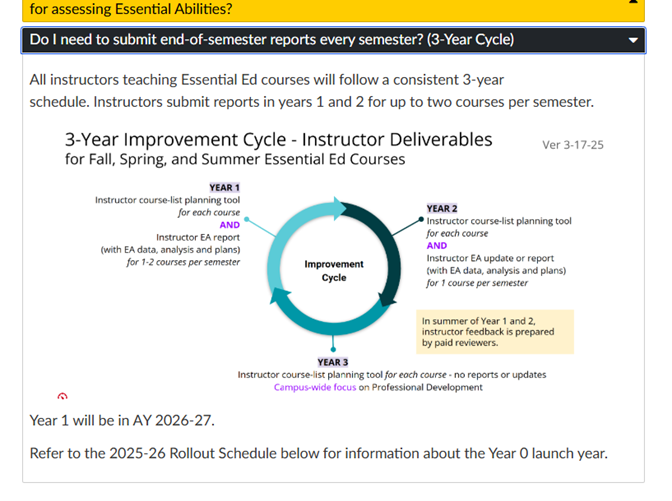Last week’s article introduced the Essential Abilities (EA) continuous improvement process—a faculty-guided approach to enhance student learning through intentional course planning, EA assessment, and reflection. At its center are two core course-level activities:
- Completing the Planning Tool at the start of each semester to identify targeted EAs, align assignments, and request support
- EA Reporting, a reflective process at the semester’s end that documents student outcomes, improvements made, and plans for continued course enhancement
Why This Matters
This is more than a compliance task—it’s a collaborative initiative focused on improving teaching and student learning. By intentionally connecting planning, assessment, and reflection, the process:
- Creates a sustainable, collaborative improvement cycle
- Supports meaningful student progress toward Essential Abilities
- Ensures faculty insight and expertise guide course- and program-level decisions
Looking Ahead: The 3-Year Improvement Cycle (Starting Fall 2026)
Starting in Fall 2026, all Essential Ed instructors will follow a 3-Year Improvement Cycle designed to balance meaningful engagement with manageable workload.
The cycle includes:
- Year 1: Submit Planning Tool for each course at semester start; full EA Reports for 1–2 courses at semester end
- Year 2: Submit Planning Tool for each course at semester start; either a short update or one full EA Report per semester
- Year 3: Submit only Planning Tool for each course at semester start; focus on reflection, peer learning, or course improvements without end-of-semester reports
Submitted reports will be reviewed over the summer by compensated peer reviewers, who will:
- Provide individualized feedback to instructors
- Identify cross-course themes and support needs
- Share findings with the Essential Ed Steering Committee to inform program development, faculty support, and recognition initiatives
Ongoing Essential Ed team support helps maintain this balance throughout the cycle, and the feedback loop strengthens both teaching practice and the Essential Ed program.
How This Approach Supports Ongoing Improvement
At the course level, this approach helps instructors by providing clear structures for intentional course design, ongoing adjustments, and reflective teaching. By aligning course goals with Essential Abilities (EAs) from the start, addressing challenges in real time, and reflecting on what worked, instructors can continuously improve their teaching methods. This process not only supports student learning but also fosters a collaborative environment where effective practices are recognized and shared.
| Core Function | What It Does |
| Promotes Intentional Design | Aligns course goals with Essential Abilities from the start |
| Adjusting in Real-Time | Helps instructors address student needs with timely adjustments. |
| Fosters Reflective Teaching | Encourages review of what worked—and what could improve |
| Supports Recognition | Surfaces effective practices through peer feedback |
| Closes the Loop | Links planning to results, enabling meaningful course adjustments |
At the program-level, this process highlights effective teaching practices, offering instructors the chance to share successes and be recognized, which leads to improvements in teaching methods, support systems, and the overall structure and effectiveness of program delivery.
This Year’s Soft Launch (Fall 2025 – Spring 2026)
EA Reporting is piloting during 2025–26, focused on first-year courses taught alongside or following the Essential Ed Seminar, where students first encounter the Essential Abilities. Participating courses include:
- Composition
- Foundations
- Lower-level Math and Science List courses
Instructors in these courses will complete an end-of-semester EA Report—using the provided template—to reflect on Essential Abilities integration, student outcomes, and areas for improvement.
If unsure whether your course is included, contact essentialed@mtu.edu.
For full details on the EA Report and preparation guidance, see What’s in the EA Report below or visit the Instructor EA Reporting page in the Canvas Resource Hub.
What’s in the EA Report?
Whether part of the soft launch or preparing for full rollout in 2026, the EA Report offers a structured way to reflect on your course’s support for student learning through Essential Abilities.
Soft launch participants will:
- Document course learning objectives and their alignment with Essential Abilities
- Describe assignments and connection to HuskyFolio
- Explain assessment methods
- Report student performance (% meeting/exceeding expectations)
- Reflect on successes and improvement areas
- Submit two anonymized student work samples (one at Developing level, one at Beginning or Proficient level depending on course level)
Submit all materials via the Canvas upload form.
EA Reporting: What You Can Do Now
Whether you’re submitting this year or preparing for 2026, here’s how to get ready:
- Review the EA Report template and upload form
- Revisit your EA plan—are assignments clearly aligned with your selected abilities?
- Explore the Canvas Resource Hub for sample rubrics, assignments, and performance criteria
- Evaluate your data plan—will it give you actionable insights?
- Reach out to your Course List Team for support at any stage
You are Helping Shape This Work
This pilot and the feedback collected will directly influence how EA Reporting evolves into a collaborative, manageable, and student-centered system.
Need Help?
Contact:
- essentialed@mtu.edu
- Your Course List Team (specific to your course type) – Refer to Need assistance? in the Canvas Resource Hub
Thanks for being part of this thoughtful rollout. We’re excited to build this together—one course at a time!
Author: Jeannie DeClerck – Office of Assessment for Curricular Effectiveness
